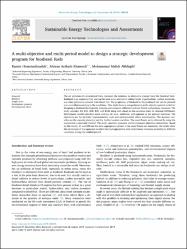A multi-objective and multi-period model to design a strategic development program for biodiesel fuels
Abstract
The air pollution of conventional fuels, increases the tendency to alternative cleaner fuels like biodiesel fuels. Biodiesel is an expensive fuel and can be used as an additive to reduce levels of particulates, carbon monoxide, and other pollutants released from diesel fuel. The proportion of biodiesel in the produced fuel can be planned and controlled according to the conditions. This study forms a comprehensive multi-objective-period model for designing a biodiesel development program and compares different biodiesel blends and primary resources. The study considers B5, B10, B20, B40, and B100 along with diesel as the candidate fuels for demand fulfillment; furthermore, model considers waste cooking oil, soya, sunflower, and rapeseed as the primary resources. The objectives are the facilities' implementation costs and environmental effects minimization. The decision variables are the capacity planning and the facility location variables. The exact Pareto set is obtained by using the augmented e-constraint method. The study considers economic and environment objectives interactions. Based on the results, B5 and B40 are the most appropriate options in the exact Pareto set; moreover, the results show the advantages of this approach to select the most appropriate fuels and primary resources according to different conditions during the studied period.
Volume
36Collections
The following license files are associated with this item:


















